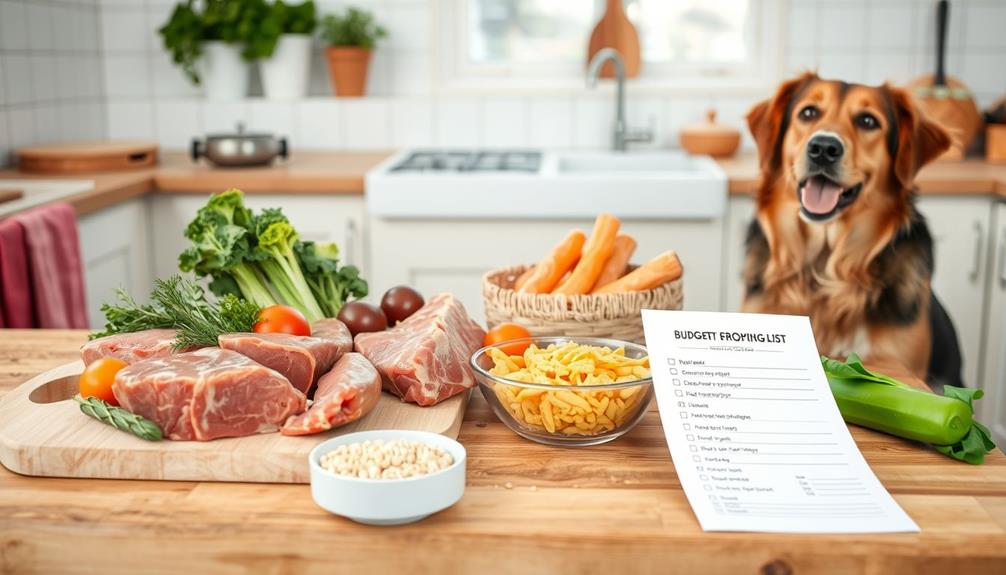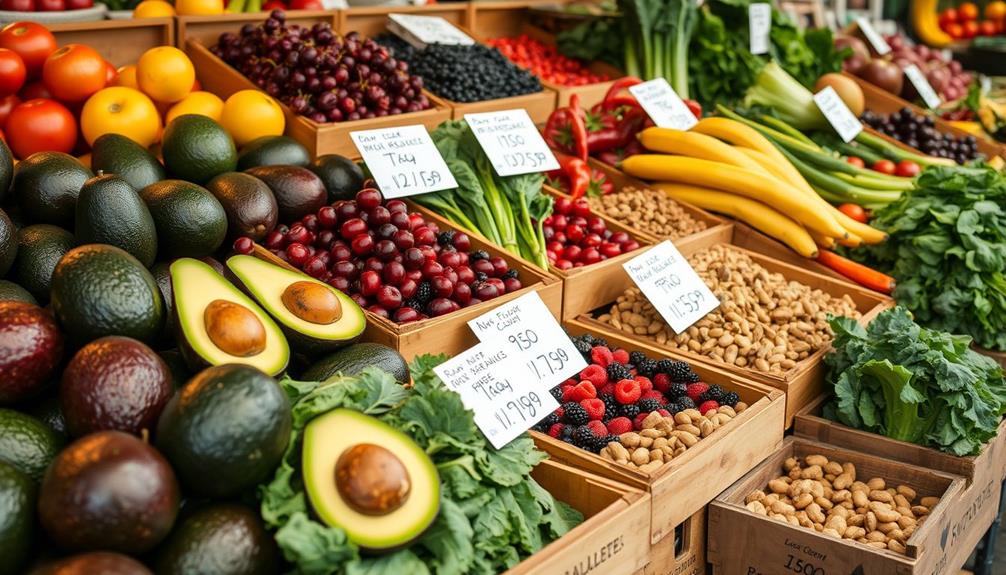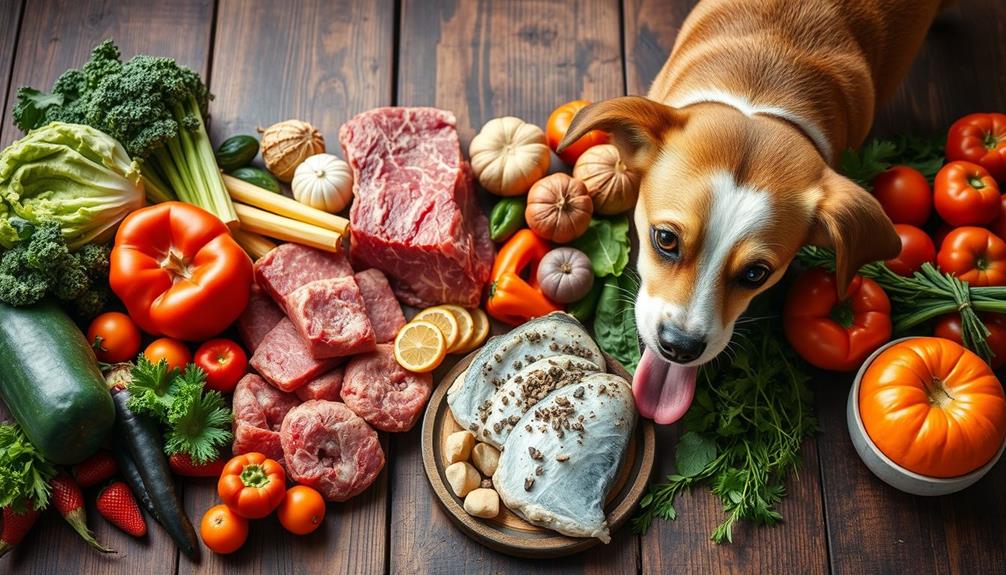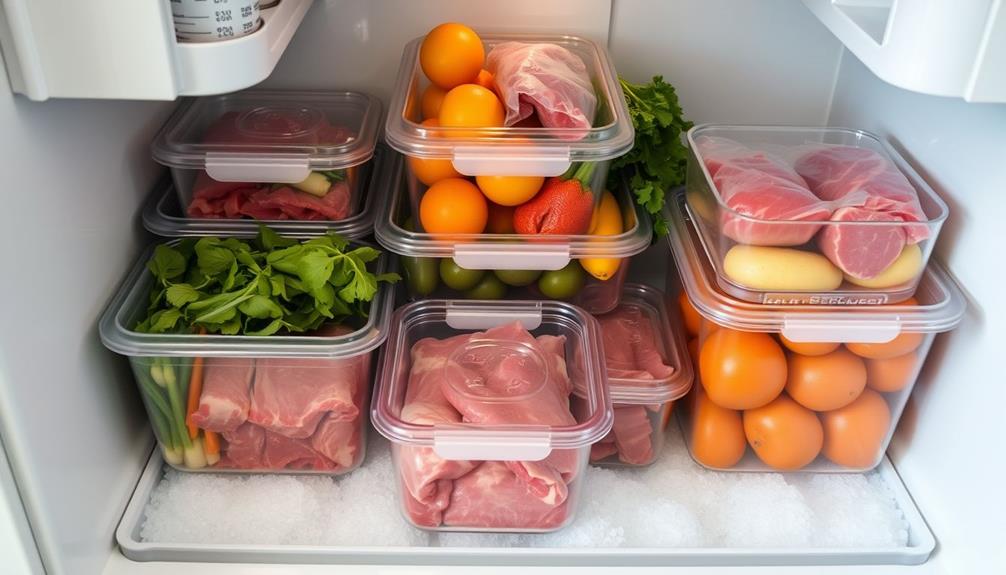Feeding your dog a raw diet on a budget is doable with some smart choices. Start by buying ingredients in bulk from local suppliers to save money. Incorporate affordable protein sources like chicken, turkey, and even chicken feet. Use raw food as a topper for existing dry food to enhance nutrition without breaking the bank. Plan meals ahead of time to minimize waste and take advantage of seasonal sales. Don't forget to include fruits and vegetables for added nutrients. If you're curious about more tips and techniques to optimize your dog's raw diet, there's plenty more to explore.
Key Takeaways
- Purchase raw ingredients in bulk from local suppliers to reduce costs and take advantage of discounts.
- Use raw food as a topper for dry kibble to enhance nutrition without fully transitioning.
- Incorporate affordable protein sources like chicken feet, turkey scraps, and organ meats for balanced nutrition.
- Meal plan and portion out raw food to minimize waste and optimize usage.
- Rotate protein sources to provide variety and prevent meal fatigue while ensuring balanced nutrition.
Budget-Friendly Raw Feeding Strategies
Feeding your dog a raw diet doesn't have to break the bank. You can easily incorporate affordable raw dog food into your routine without stretching your finances. Start by using raw ingredients as a topper for your dog's existing dry food. This method boosts nutrition while keeping costs manageable.
Additionally, consider the benefits of including fresh fruits and vegetables, which can enhance your dog's diet and provide essential nutrients proper diet for pets.
Consider purchasing raw ingredients in bulk from local suppliers. This strategy often allows you to take advantage of discounts, greatly reducing long-term expenses. Look for budget-friendly protein sources like chicken, turkey, and tripe, which are typically cheaper than lamb or venison.
Don't overlook inexpensive raw options like chicken feet and carcasses; they offer great nutritional benefits without the hefty price tag.
Rotating proteins is another effective strategy. By buying variety boxes, you guarantee a balanced diet for your dog while lowering overall costs. Keep an eye on your grocery store for sales or special offers on these protein sources.
Feeding raw can be both economical and nutritious, so with a little planning and creativity, you can provide your dog with a healthy diet that fits your budget.
Bulk Buying and Meal Planning
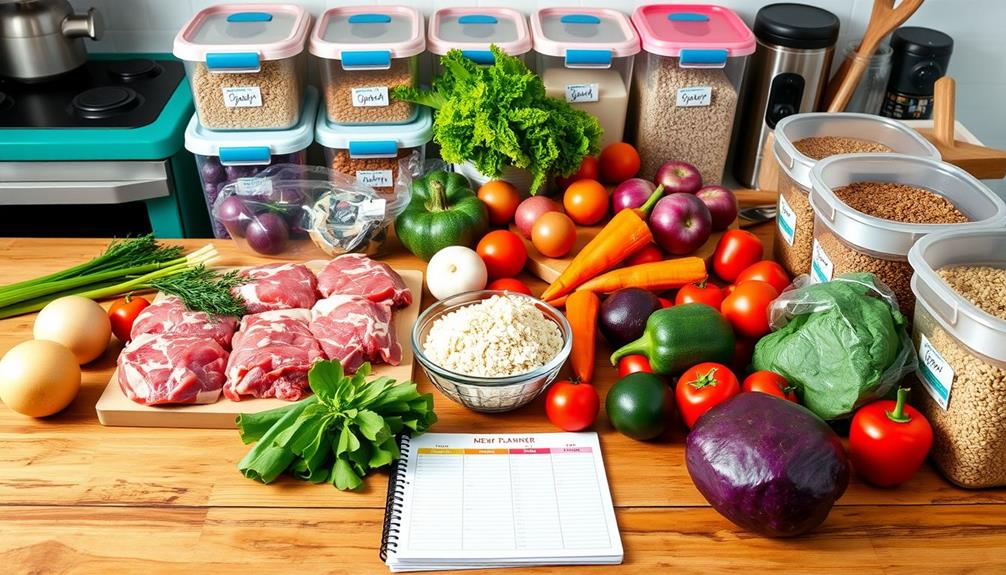
Bulk buying raw dog food can be a game changer for your budget and your dog's nutrition. When you opt for buying in bulk, like 18 lb bulk boxes or 5 lb patties, you not only save money but also simplify your meal planning.
This approach is especially beneficial for pet owners of healthy dog snacks that require consistent nutrition. It makes it easier to maintain a balanced raw food diet for your dog without worrying about constant grocery trips.
Thawing and measuring portions from bulk purchases helps you accurately feed your dog while minimizing waste. It encourages a consistent feeding routine, which is vital for your pet's health.
Plus, having a large freezer for freeze storage is ideal—especially in multi-pet households—allowing you to stock up without cluttering your kitchen.
Meal planning becomes a breeze when you buy in bulk. You can try different raw meals and identify your dog's preferred protein sources, ensuring they get the nutrition they need.
Just remember to prioritize food safety by properly storing and handling the meat. For pet parents looking to provide quality nutrition on a budget, bulk buying and effective meal planning are essential strategies to contemplate.
Affordable Protein Sources
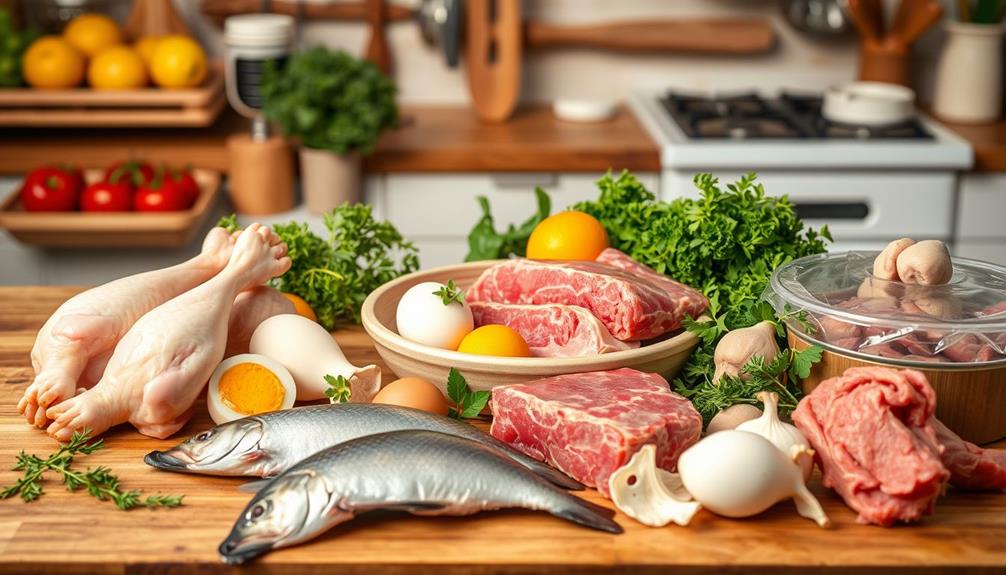
When it comes to feeding your dog raw food on a budget, finding affordable protein sources is key.
Emphasizing natural ingredients, just like the modern farmhouse decor trends in home design, can help you create a wholesome diet for your pup.
Chicken, beef, and even seasonal game meats can cut costs while keeping your pup healthy.
Budget Protein Options
Finding affordable protein options for your dog's raw diet can really help stretch your budget. Incorporating a variety of protein sources not only keeps costs down but also guarantees your pup gets essential nutrients. Here are some budget-friendly protein options to take into account:
| Protein Source | Benefits | Cost-Effectiveness |
|---|---|---|
| Chicken | Economical and versatile | High availability |
| Ground Meat | Includes turkey and pork | Affordable alternatives |
| Chicken Feet | Rich in calcium and nutrients | Low-cost option |
| Fish Scraps | Great source of omega-3s | Often discarded, cheaper |
| Rotating Proteins | Prevents meal fatigue | Maintains balanced diet |
When you choose budget protein options like chicken and ground meat, you can create balanced meals without breaking the bank. Don't forget to include chicken feet or necks for added calcium. Fish scraps from local markets can also provide variety and essential fatty acids. By regularly rotating these affordable protein sources, you're guaranteeing your dog gets the nutrition they need while keeping your expenses manageable.
Seasonal Ingredient Savings
Exploring seasonal ingredient savings can greatly enhance your dog's raw diet while keeping costs low. One of the best ways to find budget-friendly protein is by incorporating seasonal game meats during hunting seasons. These options are often less expensive and can provide excellent nutrition.
Additionally, don't overlook holiday sales for chicken and turkey; stocking up during these times can markedly reduce your protein costs. Incorporating nutrient-rich organ meats like liver can also be a cost-effective way to boost your dog's diet.
Local farmers' markets are another great resource. They frequently offer discounts on fresh, in-season produce that can add crucial nutrients to your dog's meals. You can also find organ meats, like liver, at local butchers, which are often cost-effective and enhance the nutrient density of your homemade raw food.
If you have the storage space, consider bulk buying opportunities for proteins like beef and chicken. Purchasing larger quantities during sales events can lead to impressive savings.
Health Benefits of Raw Diet
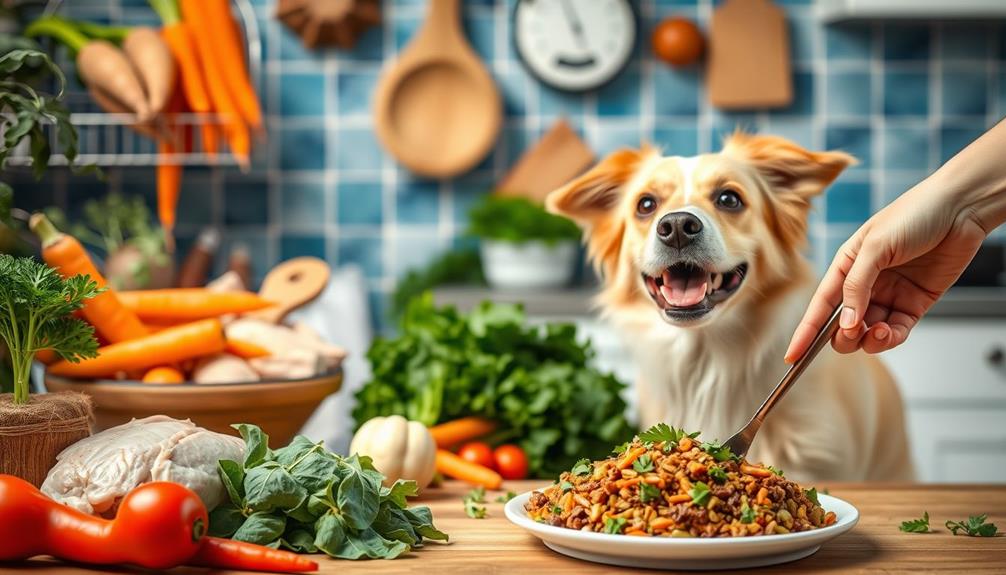
Feeding your dog a raw diet can bring a host of health benefits that enhance their overall well-being. When dogs eat raw meat, they often experience improved digestion and reduced allergy symptoms, thanks to the natural enzymes and nutrients found in these foods. A balanced raw diet supports a stronger immune system, which can lead to fewer veterinary visits and lower healthcare costs over time.
Additionally, incorporating certain aspects of cold medications overview can help address any seasonal allergies that may arise, further improving your dog's health.
Moreover, a raw diet promotes dental health. The natural chewing of raw bones helps reduce plaque and tartar buildup, resulting in cleaner teeth and fresher breath. You'll also notice that dogs consuming a raw diet tend to have smaller, firmer feces, making clean-up easier for you.
Additionally, many pet owners report increased energy levels and liveliness in their dogs after switching to raw food. This boost in energy contributes to a more active lifestyle, enhancing your dog's overall quality of life.
Choosing Raw Dog Food Brands
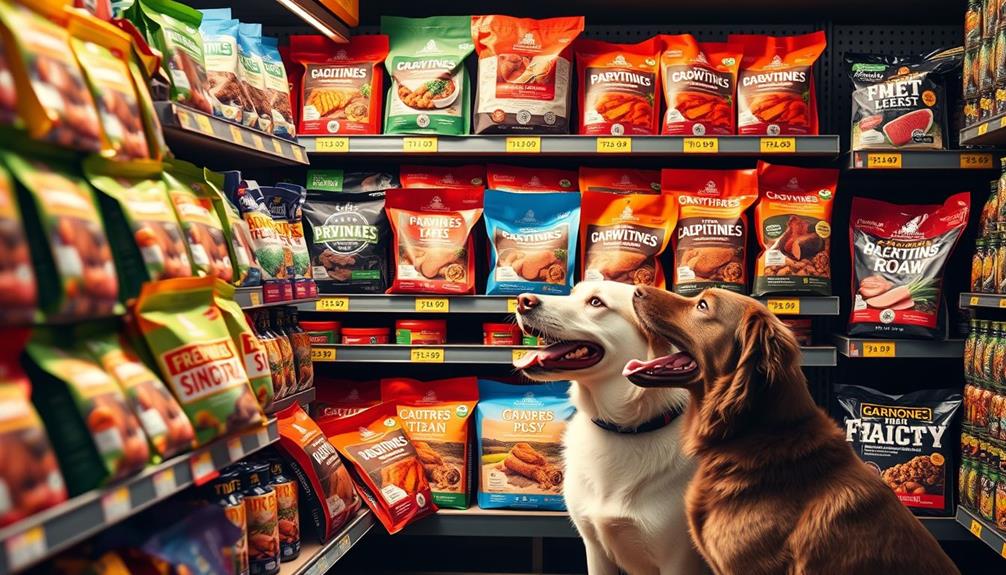
When it comes to adopting a raw diet for your dog, choosing the right food brand is just as important as understanding its health benefits. Start by prioritizing raw dog food brands that emphasize high-quality sourcing and transparent ingredient lists. This guarantees your furry friend gets nutritious and safe meals.
Look for brands with HACCP certification, which signifies they meet strict food safety standards during production. Additionally, consider brands that offer a variety of proteins to promote diversification strategy in your dog's diet, as this can help prevent allergies and provide complete nutrition.
It's also wise to check customer reviews and testimonials. These insights can help you gauge the effectiveness and palatability of different raw food brands.
When comparing options, focus on the nutritional profiles, paying close attention to the balance of proteins, fats, and essential vitamins. This will help you find the best fit for your dog's dietary needs.
Cost-Saving Tips for Raw Feeding

Raw feeding your dog doesn't have to break the bank. You can maximize your savings by purchasing raw ingredients in bulk from local suppliers. Buying larger quantities usually lowers the price per pound, which helps you stick to your budget.
Focus on affordable protein sources like chicken and beef, as they're often cheaper than options like lamb or venison. Additionally, consider exploring financial considerations for elderly care to help gauge how to manage expenses effectively.
To further manage costs, consider using raw food as a topper for your dog's existing dry food. This approach boosts nutrition without requiring a full switch to an all-raw diet. You might also try feeding one raw meal a day instead of two. This simple change can markedly reduce your overall food costs while still providing health benefits for your dog.
Another savvy tip is to team up with other dog owners. Share bulk purchases to take advantage of discounts, ensuring you have a variety of meats without incurring high individual costs.
Frequently Asked Questions
How to Afford to Feed Your Dog Raw?
Feeding your dog raw doesn't have to break the bank. Buy in bulk, focus on affordable proteins, and consider sharing costs with fellow dog owners. You'll find creative ways to keep expenses manageable while enhancing nutrition.
How to Make Cheap Raw Dog Food?
To make cheap raw dog food, buy bulk protein like chicken and turkey. Mix bone-in meat with organ meat and veggies for balance, and look for seasonal sales or discounts to save even more.
How Can I Save Money on Raw Dog Food?
You can save money on raw dog food by buying in bulk, choosing affordable protein sources, sharing costs with other owners, using raw food as a topper, and watching for seasonal sales on ingredients.
Is It Cheaper to Make or Buy Raw Dog Food?
It's generally cheaper to make raw dog food than to buy it. You can control costs by sourcing ingredients in bulk and creating balanced meals at home, which often saves you money compared to pre-packaged options.
Conclusion
As you commence on this journey of feeding your dog raw food, think of it as planting a garden. With careful planning and nurturing, you'll reap the rewards of health and energy for your furry friend without breaking the bank. Embrace bulk buying and affordable protein sources as your seeds, and watch them flourish into a thriving lifestyle. By investing time and effort, you're not just feeding your dog; you're cultivating a bond that blooms with every meal.

